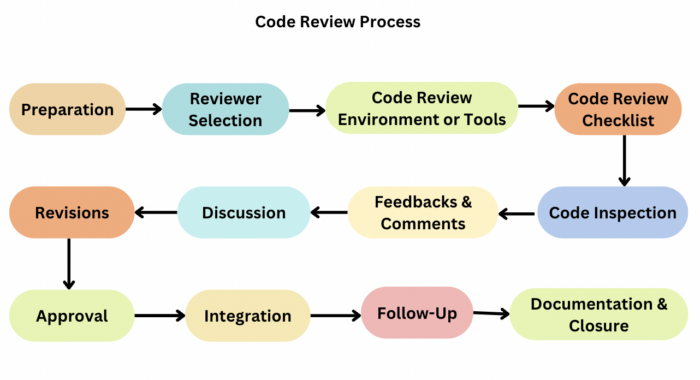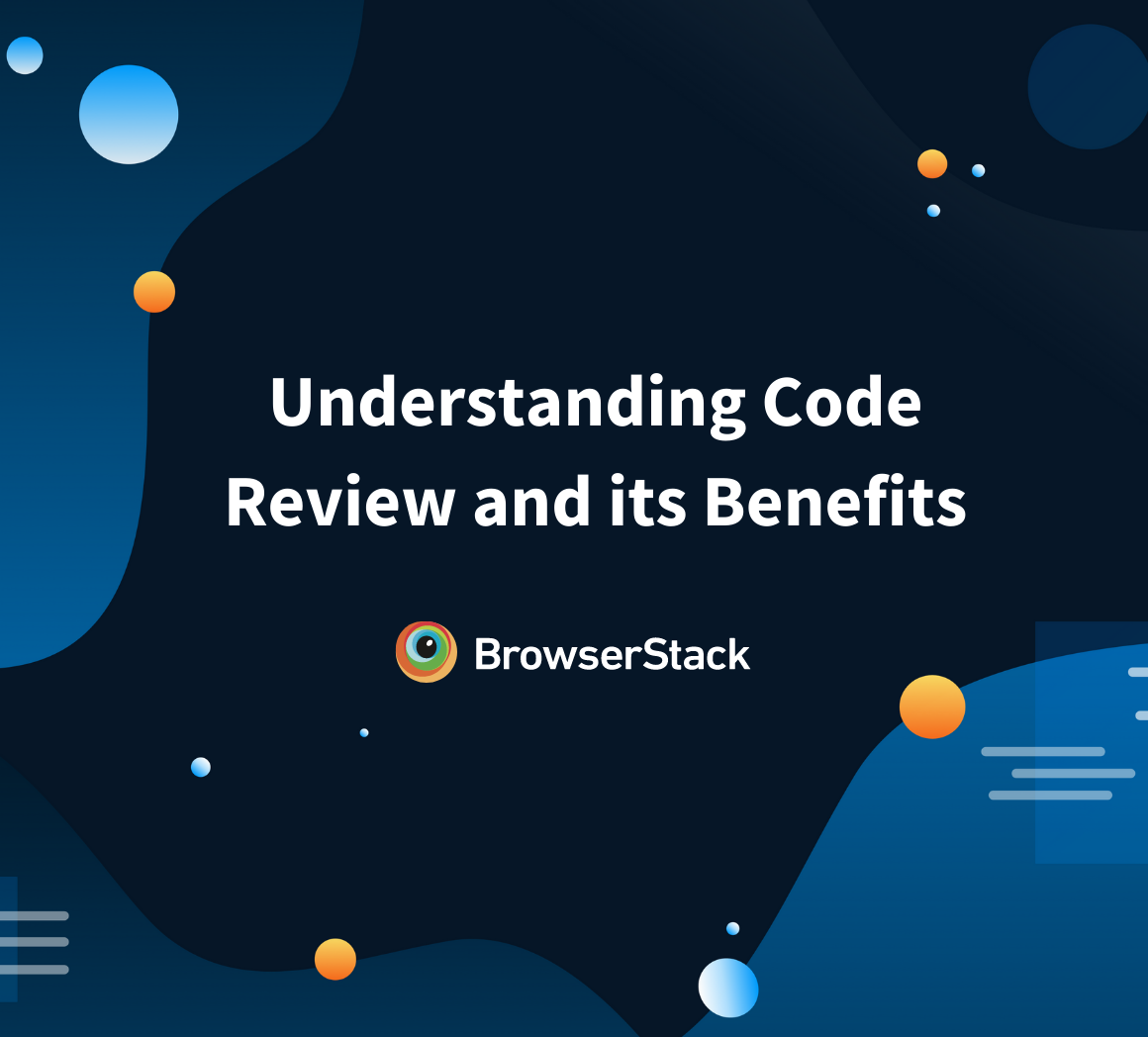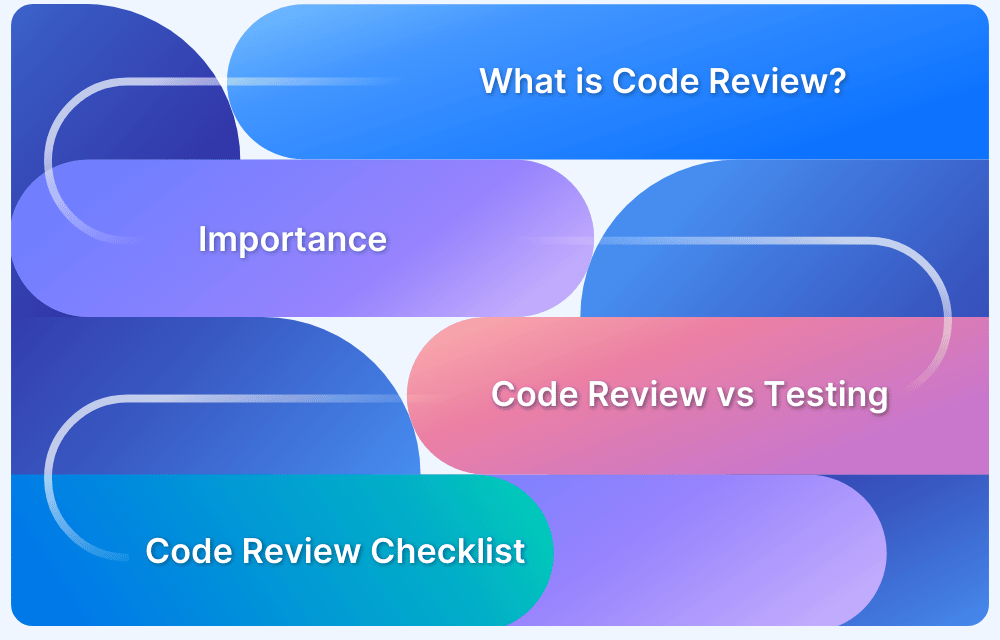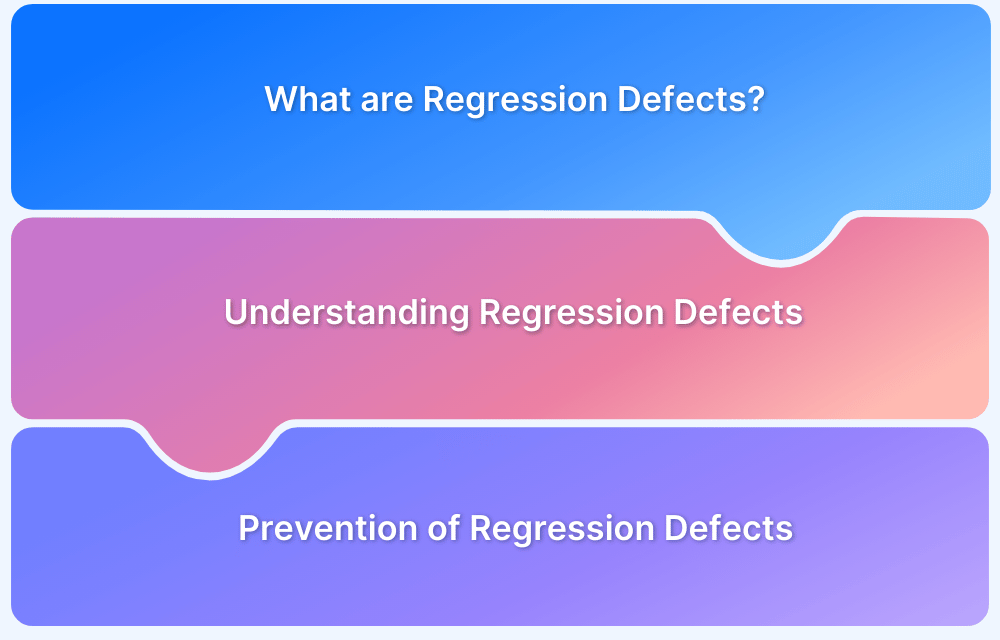In software development, maintaining code quality is just as important as writing new features. One of the most effective ways to achieve this is through code reviews, an essential practice that helps teams deliver clean, secure, and maintainable code.
Overview
What is Code Review?
Code review is a structured process where developers examine code changes to ensure quality, correctness, and security before merging. It helps catch bugs, enforce coding standards, and improve collaboration for more reliable software.
Types of Code Review:
- Pull Request (PR) Reviews
- Pair Programming
- Over-the-Shoulder Reviews
- Tool-Assisted Reviews
- Email-Based Review
- Checklist Review
- Ad Hoc Review
- Formal Inspection
Code Review Process
- Preparation
- Reviewer Selection
- Code Review Environment or Tools
- Code Review Checklist
- Code Inspection
- Feedbacks and Comments
- Discussion
- Revisions
- Approval
- Integration
- Follow-Up
Benefits of Code Review:
- Enhanced Code Quality
- Knowledge Sharing
- Consistency
- Security Improvements
- Team Collaboration
- Ownership
- Documentation
- Code Reusability
This guide describes code review, its significance, types, advantages and disadvantages, and more.
What is Code Review?
Code review is a systematic and collaborative process in software development where one or more developers examine and evaluate another developer’s code to identify any issues, provide any feedback, and ensure that the code meets quality standards. The primary goal is to improve the maintainability, quality, and reliability of the codebase resulting in the overall success of a project while also promoting knowledge sharing and learning among team members.
Why is Code Review important?
Code review is crucial in software development due to the following aspects:
- Bug Detection and Prevention: Code review helps detect and address errors, bugs, and issues in the code before they propagate to production. This early detection significantly helps in reducing the cost and effort required to fix problems later in the development process or after deployment.
- Improved Quality of Code: Code review encourages writing of clean, maintainable, and efficient code. Reviewers can suggest enhancements, recommend best practices, and ensure that the code aligns with the established coding standards and guidelines.
- Consistency: Code review enforces consistency in coding style and practices across the team which makes the codebase easier to maintain and understand.
- Knowledge Sharing and Learning: Code reviews offer opportunities for knowledge sharing among team members to learn from one another. Discussions during these reviews can help spread domain knowledge and best practices.
- Code Ownership: Code reviewers take partial ownership of the code they review thereby encouraging collective responsibility for the software’s quality.
- Collaboration: Reviewers can collaborate during the review process, discussing design decisions, trade-offs, and alternative solutions which can lead to improved design decisions and more robust solutions.
- Documentation: Code reviews can also serve as a form of documentation. Review comments and discussions capture insights and decisions that may not be noticeable from the code itself.
- Quality Assurance: Code review is a critical part of quality assurance processes. By thoroughly analyzing the code changes, teams can ensure that the software meets the functional requirements and user expectations.
- Continuous Improvement: Teams can often use code review as a tool for continuous improvement. By analyzing the patterns of the feedback of code review, teams can identify recurring issues and work on addressing them through training or process improvements.
Read More: Understanding Code Review and its Benefits
Types of Code Review
Code reviews can take various forms depending on the team’s preferences. Some common types of code review are as follows:
- Pull Request (PR) Reviews: In Git-based version control systems like GitHub, etc., developers often create pull or merge requests to propose changes to the codebase. These pull requests are reviewed by the team members before the changes are merged.
- Pair Programming: In pair programming, two developers work together on the same computer, with one writing code while the other reviewing it in real time. This form of code review is highly interactive.
- Over-the-Shoulder Reviews: A developer may ask a team member to review their code by physically sitting together and going through the code on the computer screen.
- Tool-Assisted Reviews: Various tools and platforms are available to facilitate code reviews, such as GitHub, GitLab, Bitbucket, and code review-specific tools like Crucible and Review Board.
- Email-Based Review: In email-based reviews, code changes are sent via email, and the reviewers provide feedback and comments in response. The discussion occurs over email threads.
- Checklist Review: In a checklist review, a checklist is used to evaluate the code. Reviewers go through the list and check off items as they are reviewed.
- Ad Hoc Review: Ad hoc reviews are informal and spontaneous. Developers may spontaneously ask team members to take a quick look at their code or discuss changes without a formal process.
- Formal Inspection: Formal inspections are a structured form of code review that follows a predefined process. They often involve a dedicated inspection team and detailed documentation.
How to perform a Code Review?
Performing code review involves a structured and collaborative process. The following steps are involved in reviewing code:
- Preparation: The developer who has completed a piece of code or feature initiates the code review by creating a review request or notifying the team.
- Reviewer Selection: One or more team members are assigned as reviewers. Reviewers must have the relevant expertise to assess the code properly.
- Code Review Environment or Tools: Code reviews are often facilitated using specialized tools or integrated development environments (IDEs) that allow reviewers to view the code changes and leave feedback.
- Code Review Checklist: Reviewers may refer to a code review checklist or coding standards to ensure that the code follows established guidelines.
- Code Inspection: Reviewers examine the code thoroughly, looking for issues such as: syntax errors, logic errors, performance bottlenecks, security vulnerabilities, coding standard consistencies, adherence to best practices along with the code’s overall design, scalability, and maintainability.
- Feedbacks and Comments: Reviewers provide comments within the code review tool, explaining any issues they find. These comments should be clear, constructive, and specific, making it easier for the author to understand the feedback.
- Discussion: The author and reviewers engage in a discussion about the code changes. This dialogue can involve clarifications, explanations, and suggestions for improvement.
- Revisions: The author makes necessary changes based on the feedback received and continues to engage in discussions until all concerns are addressed. This may involve multiple review iterations.
- Approval: Once reviewers are satisfied with the code changes and all concerns have been resolved, they approve the code for integration.
- Integration: The approved code changes are integrated into the main codebase, typically using version control systems.
- Follow-Up: After integration, it’s crucial to monitor the code in the production environment to ensure that the changes work as expected and do not introduce new issues.
- Documentation and Closure: The code review process is documented for future reference, and the review is officially closed. This documentation may include the review comments, decisions made, and any action items.
Advantages and Limitations of Code Review
Code review has its own advantages and disadvantages. Understanding these can help teams optimize their code review practices and make better decisions about when and how to conduct reviews. Here are some of the advantages and limitations of code review:
Advantages of Code Review
- Enhanced Code Quality: Code review helps identify and correct bugs early in the development process, resulting in higher code quality.
- Knowledge Sharing: Code reviews facilitate knowledge sharing among team members.
- Consistency: Code reviews enforce coding standards and guidelines, ensuring that the codebase is consistent and easier to maintain.
- Security Improvements: Code review can help identify and mitigate security vulnerabilities, improving the overall security of the software.
- Team Collaboration: Code reviews encourage collaboration and communication among team members. They provide a structured forum for discussing code changes and making collective decisions.
- Ownership: Code ownership becomes collective, reducing dependencies on specific individuals since the reviews take partial ownership of the code being reviewed.
- Documentation: Code reviews often involve discussions and comments, which can serve as a form of documentation.
- Code Reusability: By examining code thoroughly, developers can identify opportunities for code reuse, leading to more efficient and maintainable software development.
Limitations of Code Review
- Time-Consuming: Code review can be time-consuming, especially for large or complex code changes. This may lead to delays in the development process.
- Subjectivity: Code review feedback can be subjective, and different reviewers may have different opinions on the code style and quality.
- Overhead: Excessive code reviews, especially for trivial changes, can create unnecessary overhead and slow down development.
- Reviewer Bias: Reviewers may have biases or blind spots that can influence their feedback. They may focus on certain aspects of the code while overlooking others.
- Communication Challenges: Reviewers and authors may face challenges in effectively communicating feedback and understanding each other’s perspectives.
- Skill Level: The effectiveness of code reviews can vary depending on the skill level and experience of the reviewers. Inexperienced reviewers may miss important issues, while highly experienced ones may be overly critical.
- False Positives: Reviewers may identify issues that are not actually problems, leading to unnecessary discussions and changes.
- Mental Fatigue: Reviewers can experience mental fatigue, especially during lengthy or frequent code reviews, which can reduce their ability to provide thorough feedback.
Difference between Code Review and Code Quality
While Code Review and Code Quality are closely related, they serve different purposes in software development.
| Feature | Code Review | Code Quality |
|---|---|---|
| Purpose | Identify issues, enforce coding standards | Measure maintainability, readability, and efficiency |
| Focus | Reviewing recent code changes | Assessing overall codebase quality |
| Method | Manual peer review or automated tools | Metrics-based evaluation and long-term monitoring |
| Scope | Specific code changes (like pull requests) | The entire codebase |
| Tools Used | GitHub PR reviews, Bitbucket, Gerrit, SonarQube | Tools like BrowserStack Code Quality |
| Outcome | Better code in individual commits | Long-term code maintainability and performance |
Similarities Between Code Review and Code Quality
While code review and code quality have distinct roles, they share several common objectives and contribute to overall software excellence.
- Improve maintainability: Ensure code is readable, structured, and reduces technical debt.
- Identify issues early: Detect bugs, logical errors, and vulnerabilities before deployment.
- Enforce coding standards: Maintain best practices and team-specific guidelines.
- Enhance performance & reliability: Optimize code for stability, scalability, and efficiency.
- Support CI/CD pipelines: Integrate with automated quality checks for consistent validation.
Both work together to ensure clean, efficient, and high-quality code throughout development
Best Practices for Code Review
Some best practices for conducting effective code reviews include the following:
- Set Clear Expectations: Define the goals and objectives of the code review. Specify coding standards, style guides, and best practices to be followed.
- Choose the Right Reviewers:Select reviewers with relevant expertise in the codebase and the problem domain. Consider having both experienced and junior developers participate to promote knowledge sharing.
- Review Small, Digestible Changes: Avoid reviewing too much code at once. Break down large tasks into smaller, manageable units for review.
- Provide Context: Include a description of the change, its purpose, and any relevant background information in the code review request. Reference relevant user stories, issues, or tickets.
- Use Code Review Tools: Utilize code review tools and platforms (e.g., GitHub, GitLab, Bitbucket, or specialized code review tools) to facilitate the process. Leverage features like inline comments and code diff views.
- Focus on Code Quality: Review for code quality, maintainability, and adherence to coding standards. Check for code duplications, and proper error handling.
- Check for Security Vulnerabilities: Be vigilant about potential security vulnerabilities, such as injection attacks, authentication issues, and data exposure.
- Test the Code: Reviewers should test the code changes whenever possible. This includes running the code locally, testing edge cases, and verifying that the changes solve the problem.
- Provide Constructive Feedback: Offer feedback in a constructive and respectful manner. Point out issues with specific code sections and suggest improvements or alternatives.
- Maintain a Positive and Collaborative Tone: Foster a culture of collaboration and learning. Encourage open discussions and dialogue between the author and reviewers to resolve issues and disagreements.
- Follow Up on Feedback: Authors should address all feedback and comments promptly. Reviewers should verify that their feedback has been addressed satisfactorily.
- Keep Reviews Timely: Aim to complete code reviews in a timely manner to avoid delays in the development process. Set expectations for review turnaround times.
- Document Decisions: Record and document discussions, decisions, and reasons for code changes. This documentation can serve as a valuable resource for future reference.
- Learn from Code Reviews: Use code reviews as a learning opportunity for both authors and reviewers. Encourage knowledge sharing and continuous improvement.
- Regularly Review Code Review Practices: Periodically assess and refine your code review process to adapt to changing team dynamics and project needs.
Conclusion
Code review is a crucial step in software development, ensuring quality, maintainability, and security of code through peer evaluation and following best practices. A strong review process leads to cleaner, more efficient code and reduces technical debt over time.
BrowserStack provides detailed logs, video recordings, screenshots, and real-time debugging tools to streamline the code review process. With comprehensive test reports, teams can quickly analyze failures, trace issues, and optimize code quality.








